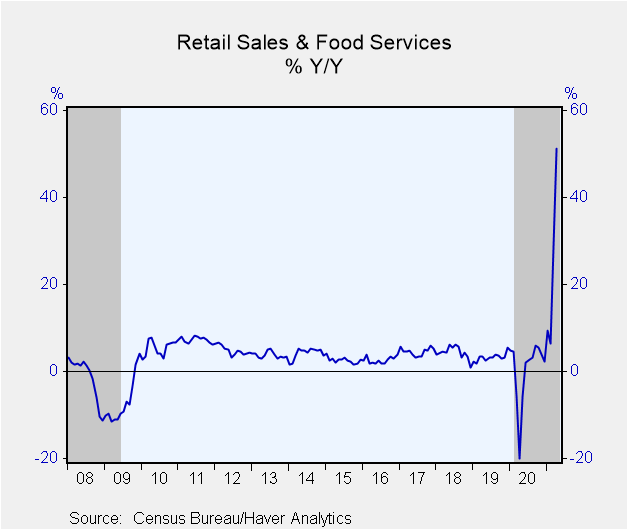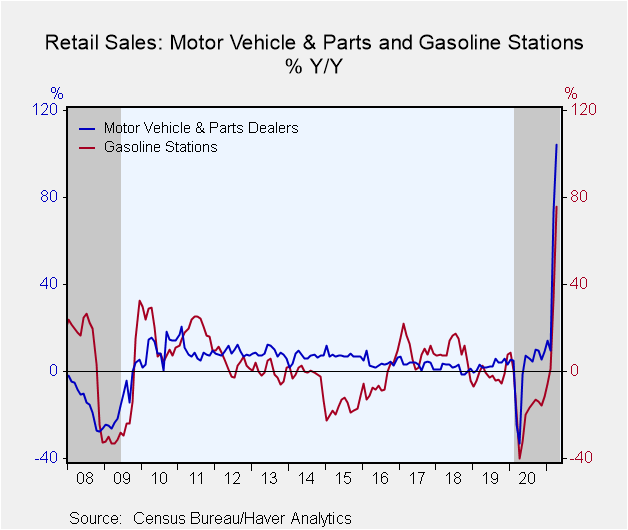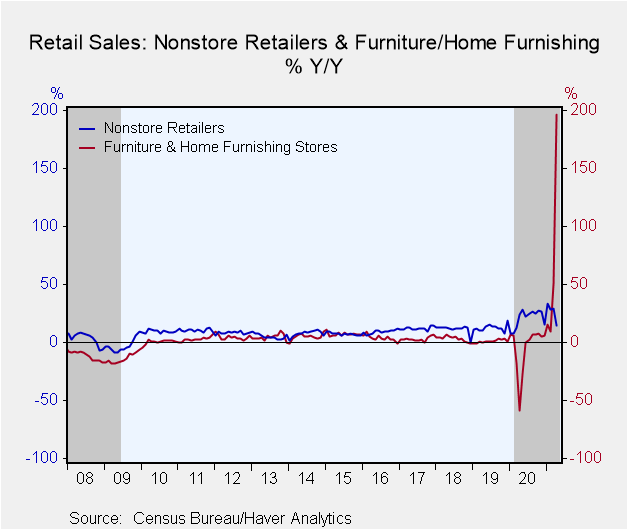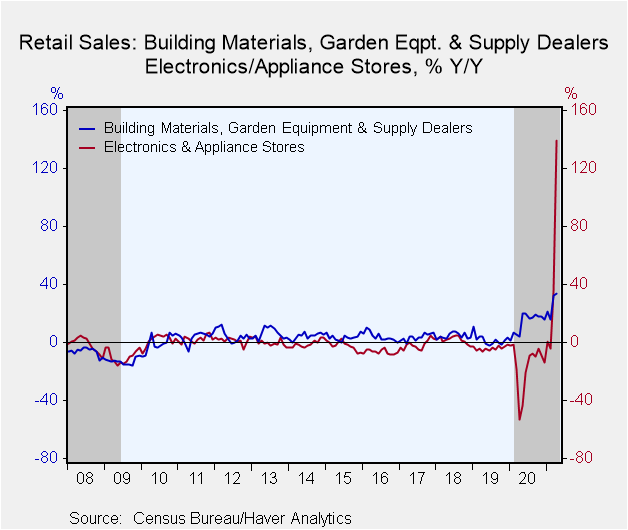 Global| May 14 2021
Global| May 14 2021U.S. Retail Sales Hold Steady in April
by:Tom Moeller
|in:Economy in Brief
Summary
• Stability follows near record March strength. • Weakness was broad-based. • March reading was upwardly revised. The consumer took a breather after store re-openings and government-issued $1,400 checks stimulated spending during [...]
• Stability follows near record March strength.
• Weakness was broad-based.
• March reading was upwardly revised.
The consumer took a breather after store re-openings and government-issued $1,400 checks stimulated spending during March. Total retail sales including food service and drinking establishments held steady (51.2% y/y) during April after strengthening an upwardly revised 10.7% in March, a gain surpassed only by a record 18.1% surge last May following extreme weakness in April. (The retail sales figures date back to February 1967). February's 2.9% decline was changed from -2.7% reported initially. A 1.3% April increase had been expected in the Action Economics Forecast Survey. Sales excluding motor vehicles and parts fell 0.8% last month (+40.6% y/y) after rising 9.0% in March, revised from 8.4%. A 0.9% April rise had been expected.
Sales in the retail control group, which excludes autos, gas stations, building materials and food services, declined 1.5% last month (+29.1% y/y) after rising 7.6% in March.
Motor vehicle purchases increased 2.9% in April (104.5% y/y) following a 17.1% March rise. The gain compares to a 2.5% improvement (112.1% y/y) in unit sales of light vehicles. Spending at clothing & accessory stores declined 5.1% (+726.8% y/y) after rising 22.7% in March. General merchandise store sales were off 4.9% last month (+15.1% y/y) after rising 9.7%. Department store sales fell 1.9% (+72.5% y/y) following strong gains in two of the prior three months. Sporting goods, hobby and book store sales fell 3.6% (+155.0% y/y) after rising by one-quarter in March. Furniture & home furnishings sales eased 0.7% last month (+196.4% y/y) after improving 8.1% while sales at electronics & appliance stores rose 1.2% (139.0% y/y) after gaining 17.5% in March. Nonstore retail sales edged down 0.6% in April (+14.5% y/y) after gaining 4.7% in March.
Building materials sales fell 0.4% (+33.8% y/y) after rising 13.9% in March. Reflecting lower gasoline prices (seasonally adjusted by Haver), service station sales fell 1.1% (+76.1% y/y) following four straight months of strong increase.
In the nondiscretionary sales categories, grocery & beverage store sales improved 0.4% in April (1.5% y/y) after rising 0.7% in the prior month. Health & personal care store sales increased 1.0% (24.7% y/y) following an 8.0% March rise.
Sales at restaurants and drinking establishments strengthened 3.0% (116.8% y/y) in April after gaining 13.5% during the prior month.
The retail sales data can be found in Haver's USECON database. The Action Economics forecast is in the AS1REPNA database.
| Retail Spending (% chg) | Apr | Mar | Feb | Apr Y/Y | 2020 | 2019 | 2018 |
|---|---|---|---|---|---|---|---|
| Total Retail Sales & Food Services | 0.0 | 10.7 | -2.9 | 51.2 | 0.3 | 3.3 | 4.4 |
| Excluding Autos | -0.8 | 9.0 | -2.7 | 40.6 | 0.3 | 3.4 | 5.1 |
| Retail Sales | -0.3 | 10.4 | -3.0 | 46.1 | 3.1 | 3.0 | 4.2 |
| Retail Less Autos | -1.4 | 8.4 | -2.8 | 33.3 | 4.0 | 3.0 | 5.0 |
| Motor Vehicle & Parts | 2.9 | 17.1 | -3.6 | 104.5 | 0.3 | 2.9 | 1.4 |
| Food & Beverage Stores | 0.4 | 0.7 | -0.5 | 1.5 | 11.5 | 3.1 | 2.9 |
| Gasoline Service Stations | -1.1 | 10.2 | 3.2 | 76.1 | -15.8 | -1.7 | 9.2 |
| Food Service & Drinking Places | 3.0 | 13.5 | -1.4 | 116.8 | -19.4 | 5.6 | 5.7 |
Tom Moeller
AuthorMore in Author Profile »Prior to joining Haver Analytics in 2000, Mr. Moeller worked as the Economist at Chancellor Capital Management from 1985 to 1999. There, he developed comprehensive economic forecasts and interpreted economic data for equity and fixed income portfolio managers. Also at Chancellor, Mr. Moeller worked as an equity analyst and was responsible for researching and rating companies in the economically sensitive automobile and housing industries for investment in Chancellor’s equity portfolio. Prior to joining Chancellor, Mr. Moeller was an Economist at Citibank from 1979 to 1984. He also analyzed pricing behavior in the metals industry for the Council on Wage and Price Stability in Washington, D.C. In 1999, Mr. Moeller received the award for most accurate forecast from the Forecasters' Club of New York. From 1990 to 1992 he was President of the New York Association for Business Economists. Mr. Moeller earned an M.B.A. in Finance from Fordham University, where he graduated in 1987. He holds a Bachelor of Arts in Economics from George Washington University.










